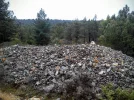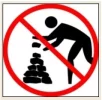- Time of past OR future Camino
- To Santiago and back. Le Puy to Aumont-Aubrac.
My question concerns the cairns that are being built along the trail and the piles of stones on the waymarkers and at the foot of Christian crosses and other memorials. Is any of this a local tradition or age-old pilgrimage tradition? I have seen the word "sorrow stones" in this connection. Where does this come from? The stones on the waymarkers - are they picked up and carried and put down again? Or are people creating these small stones piles and the cairns mainly because they see it and imitate it?
And a last question: I admit that we built a small cairn once. It was on a high mountain in the Markka valley of Ladakh which is largely Buddhist. We did it because we thought: "You never know ..." . What are they called, does anyone know? I cannot remember the name and cannot find it anywhere. They serve as individual shelters for one's soul for a certain time (weeks?) after death.
. What are they called, does anyone know? I cannot remember the name and cannot find it anywhere. They serve as individual shelters for one's soul for a certain time (weeks?) after death.
And a last question: I admit that we built a small cairn once. It was on a high mountain in the Markka valley of Ladakh which is largely Buddhist. We did it because we thought: "You never know ..."
Last edited:


















